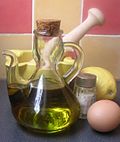Emulsion

- A: the two liquids are separated, one is on top, the other at the bottom
- B: The second liquid is dispersed in the first
- C: The unstable emulsion separates (which will lead to the picture A)
- D: Surfactant positions itself between the two liquids
An emulsion is what you get when you put two or more liquids together and the two liquids do not mix. Immiscible liquids do not mix together. For example, if you add oil to water, the oil floats on the surface of the water. And if you shake the two together then leave them to stand, tiny droplets of oil float upwards. These droplets join together until eventually the oil is floating on the water again. To stop the two liquids separating, we need a substance called an emulsifier.[1]
Emulsifiers are molecules that have two different ends, a hydrophilic end (water-loving) that forms chemical bonds with water but not with oils, and a hydrophobic end (water-hating lipophile) that forms chemical bonds with oils but not with water.[2]
Uses of Emulsion
- Usually used in cosmetics, pharmaceuticals, personal hygiene.
- Microemulsions are used to deliver vaccines to kill various microbes.
- It is used in chemical synthesis mainly in the manufacture of polymer dispersions.
- It is used in firefighting.
- Nanoemulsions such as soybean oil are used to kill microbes.
Emulsion Media
An example of the ingredients used to make mayonnaise; olive oil, table salt, an egg (for yolk) and a lemon (for lemon juice). The oil and water in the egg yolk do not mix, while the lecithin in the yolk serves as an emulsifier, allowing the two to be blended together.
Related pages
References
- ↑ "Emulsion - an overview | ScienceDirect Topics". www.sciencedirect.com. Retrieved 2021-09-04.
- ↑ "What Is an Emulsion? Definition and Examples". ThoughtCo. Retrieved 2021-09-04.
